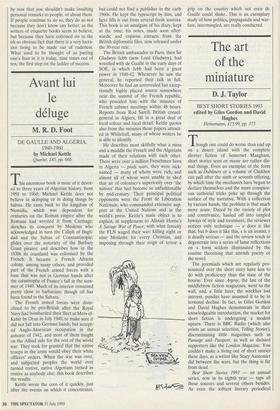The art of the miniature
D. J. Taylor
BEST SHORT STORIES 1993 edited by Giles Gordon and David Hughes Heinemann, £15.99, pp. 373 Though one could do worse than end up on a desert island with the complete shorter fiction of Somerset Maugham, short stories seen en masse are rather dis- mal things. Even an exemplar of the form such as Dubliners or a volume of Chekhov can pall after the sixth or seventh offering, by which time the mechanics have begun to declare themselves and the more conspicu- ous authorial tricks poke up through the surface of the narrative. With a collection by various hands, the problem is that much more acute. Dazed by the variety of plot and contrivance, hauled off into tangled byways of style and treatment, the reviewer notices only technique — a does it like that, but b does it like this, x is an ironist, y is deadly serious — and the review tends to degenerate into a series of lame reflections on a form seldom illuminated by the routine theorising that attends poetry or the novel.
The jeremiads which are regularly pro- nounced over the short story have less to do with proficiency than the state of the bourse. Ever since Argosy, the last of the middlebrow fiction magazines, went to the wall, and, a little later, the weeklies lost interest, pundits have assumed it to be in terminal decline. In fact, as Giles Gordon and David Hughes demonstrate in their knowledgeable introduction, the market for short fiction is undergoing a modest upturn. There is BBC Radio (which also prints an annual selection, Telling Stories), discriminating little magazines such as Panurge and Passport, as well as diehard supporters like the London Magazine. You couldn't make a living out of short stories these days, as a writer like Stacy Aumonier did between the wars, but the thing is far from dead.
Best Short Stories 1993 — an annual series, now in its eighth year — taps all these sources and several others besides. As even the loftiest literary periodical tends to have its own house style, the result is a case book of different encounters with the form: the sideways scuttle, the graceful backing away, the head-on collision. There are witty, cynical contributions to the New Yorker; precise, not-a-word-out-of-place miniatures from the airwaves, bristling, dis- cursive pieces from the little magazines (where space constraints are less obstruc- tive), bright, candid confessions from the women's monthlies, and the only part of the market ignored by this eclectic editorial trawl seems to be the literary homosexual end, represented by magazines like the European Gay Review.
Everybody, too, seems to be on particu- larly good form. Another favourite review- er's trick when confronted by a book of this sort is to lament that Mr X, that grand old man of English letters, should have seen fit to throw us such a misshapen chip from his dusty workbench, or that Mrs Y, that orna- ment of the post-war literary scene, should have plunged so dramatically below the Plimsoll line of acceptability. Gratifyingly, some of the best contributions are from the old-stagers, in particular a brilliant piece of adolescent eye-opening from Jane Gardam. Even Fay Weldon, whose short stories are generally robbed of all interest by their complete subservience to ulterior motive, unbends sufficiently to produce a plausible and funny piece about a girl married to a womanising painter.
To balance this, perhaps, is a story by Edna O'Brien which begins, 'Yes, death stalked the city that night, stalked the city like a great water wolf.' If one had to make a single distinction between the various types of story on display here, it would be between the conceit and the genuine tale. Martin Amis's 'Career Move' (which con- trasts and burlesques the ambitions of two wildly differing writers) and Jonathan Trei- tel's 'Stalin, Stalin and Stalin' (Stalin's impersonators meeting at a convention after his death) are examples of the former — stories which began life as 'good ideas' and survive on surface glitter. A good example of the latter, and the best story in the book for my money, is Alice Munro's `A Real Life', another of her reminiscences of prewar, small-town Canada whose 25 or so pages yield up at least three wholly memorable characters. Yet another review- er's trick in these circumstances is to fall back on the ancient standby of picking win- ners from among the unknowns. The best of the bunch is David Belbin — a name quite unfamiliar to me until I picked up this book — whose 'Different Ways of Get- ting Drunk' features a woman enabled to confront the fact of her lesbianism by the death of her mother. It is easy to imagine what a dreary and predictable piece this might have been in the wrong hands. Happily Belbin's treatment has an odd poignancy, the sense — so often missing from contemporary writing — of an ordi- nary, unsensational life given overwhelming interest and importance.



















































 Previous page
Previous page